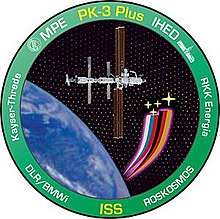PK-3 Plus (ISS experiment)

The PK-3 Plus or (Plasmakristall-3 Plus) laboratory is a joint Russian-German laboratory for the investigation of dusty/complex plasmas on board the International Space Station (ISS), with the principal investigators at the German Max Planck Institute for Extraterrestrial Physics and the Russian Institute for High Energy Densities.[1] It is the successor to the PKE Nefedov experiment with improvements in hardware, diagnostics and software. The laboratory was launched in December 2005 and has been operated for the first time in January 2006. As of September 2012, it has been used in 18 missions.
Technical description
The heart of the PK-3 Plus laboratory consists of a capacitively coupled plasma chamber. A plasma is generated by applying a radio frequency voltage signal to two electrodes. Microparticles are then injected into the plasma via dispensers that are mounted on the side of the electrodes. The microparticles are illuminated with a sheet of laser light from the side. They scatter the light, which is then recorded by up to four cameras mounted around the plasma chamber. The data from the cameras are recorded on hard drives that are physically brought back to Earth via Soyuz capsules for analysis.
Scientific goals
PK-3 Plus studies complex plasmas - plasmas that contain microparticles. The microparticles acquire high negative charges by collecting electrons from the surrounding plasma. They interact with each other and with the plasma particles, e.g., they experience a drag force from the ions that are streaming to the edges of the plasma.
Depending on the experimental settings like the gas pressure, the system made up of the microparticles forms various phases - solid, liquid or gaseous. In this sense, the microparticles can be seen as analogous to atoms or molecules in ordinary physical systems. The experiments are performed by observing the movement of the microparticles and tracing them from camera frame to frame.
The PK-3 Plus experiment allows investigating a large variety of topics, for instance: the crystal structure,[2] fluid-solid phase transitions,[3] electrorheological fluids,[4] wave propagation,[5] the heartbeat instability,[6] Mach cone formation[7] and the speed of sound,[8] and lane formation[9][10]
External links
References
- ^ Thomas, H. M. (2008). "Complex plasma laboratory PK-3 Plus on the International Space Station". New Journal of Physics. 10: 033036. doi:10.1088/1367-2630/10/3/033036.
- ^ Klumov, B. (2009). "Structural properties of 3D complex plasmas: experiments versus simulations". Plasma Physics and Controlled Fusion. 51: 124028. doi:10.1088/0741-3335/51/12/124028.
- ^ Khrapak, S. A. (2012). "Fluid-solid phase transitions in three-dimensional complex plasmas under microgravity conditions". Physical Review E. 85: 066407. doi:10.1103/PhysRevE.85.066407.
- ^ Ivlev, A. V. (2008). "First Observation of Electrorheological Plasmas". Physical Review Letters. 100: 095003. doi:10.1103/PhysRevLett.100.095003.
- ^ Schwabe, M. (2008). "Nonlinear waves externally excited in a complex plasma under microgravity conditions". New Journal of Physics. 10: 033037. doi:10.1088/1367-2630/10/3/033037.
- ^ Heidemann, R. (2011). "Comprehensive experimental study of heartbeat oscillations observed under microgravity conditions in the PK-3 Plus Laboratory on board the". Physics of Plasmas. 18: 053701. doi:10.1063/1.3574905.
- ^ Jiang, K. (2009). "Mach cones in a three-dimensional complex plasma". EPL. 85: 45002. doi:10.1209/0295-5075/85/45002.
- ^ Schwabe, M. (2011). "Direct measurement of the speed of sound in a complex plasma under microgravity conditions". EPL. 96: 55001. doi:10.1209/0295-5075/96/55001.
- ^ Sütterlin, R. (2009). "Dynamics of Lane Formation in Driven Binary Complex Plasmas". 102: 085003. doi:10.1103/PhysRevLett.102.085003.
{{cite journal}}: Cite journal requires|journal=(help) - ^ Du, C.-R. (2012). "Experimental investigation on lane formation in complex plasmas under microgravity conditions". New Journal of Physics. 14: 073058. doi:10.1088/1367-2630/14/7/073058.
